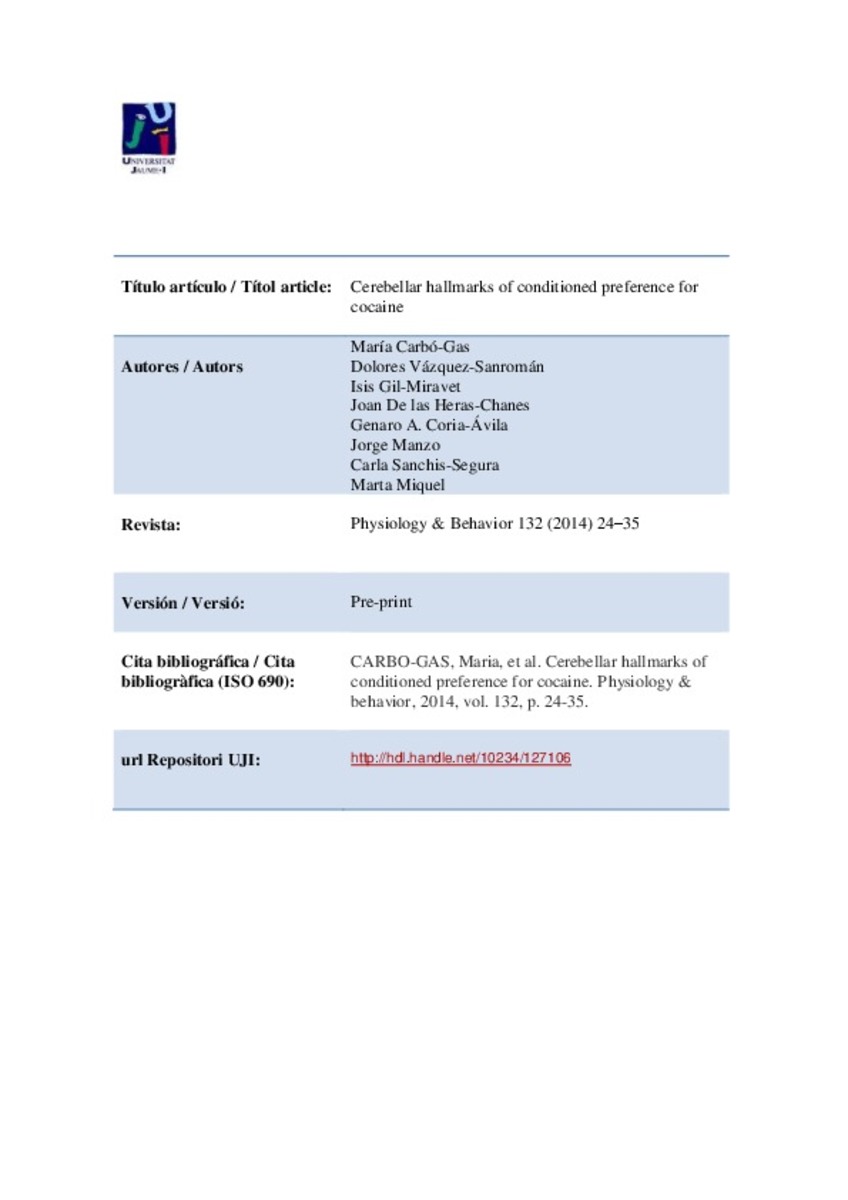Mostrar el registro sencillo del ítem
Cerebellar hallmarks of conditioned preference for cocaine
| dc.contributor.author | Carbó Gas, María | |
| dc.contributor.author | Vázquez Sanromán, Dolores | |
| dc.contributor.author | Gil-Miravet, Isis | |
| dc.contributor.author | De las Heras-Chanes, Joan | |
| dc.contributor.author | Coria Ávila, Genaro A. | |
| dc.contributor.author | Manzo, Jorge | |
| dc.contributor.author | Sanchis-Segura, Carla | |
| dc.contributor.author | MIQUEL, MARTA | |
| dc.date.accessioned | 2015-07-09T15:54:04Z | |
| dc.date.available | 2015-07-09T15:54:04Z | |
| dc.date.issued | 2014 | |
| dc.identifier.issn | 0031-9384 | |
| dc.identifier.issn | 1873-507X | |
| dc.identifier.uri | http://hdl.handle.net/10234/127106 | |
| dc.description.abstract | Pavlovian conditioning tunes the motivational drive of drug-associated stimuli, fostering the probability of those environmental stimuli to promote and trigger drug seeking and taking. Interestingly, different areas in the cerebellum are involved in the formation and long-lasting storage of Pavlovian emotional memory. Very recently, we have shown that conditioned preference for an odour associated with cocaine was directly correlated with cFOS expression in cells at the dorsal region of the granule cell layer of the cerebellar vermis. The main goal of the current investigation was to further extend the description of cFOS-IR patterns in cerebellar circuitry after training mice in a cocaine-odour Pavlovian conditioning procedure, including now the major inputs (the inferior olive and pontine nuclei) and one of the output nuclei (the medial deep nucleus) of the cerebellum. The results showed that the cerebellar hallmark of preference towards an odour cue associated to cocaine is an increase in cFOS expression in the dorsal part of the granule cell layer. cFOS-IR levels expressed in the granule cell layer of mice that did not show cocaine conditioned preference did not differ from the basal levels. Remarkably, mice subjected to a random cocaine-odour pairing procedure (the unpaired group) exhibited higher cFOS-IR in the inferior olive, the pontine nuclei and in the deep medial nucleus. Therefore, our findings suggest that inputs and the output of cerebellar circuitry are enhanced when contingency between the CS+ and cocaine is lacking. | ca_CA |
| dc.format.extent | 34 p. | ca_CA |
| dc.format.mimetype | application/pdf | ca_CA |
| dc.language.iso | eng | ca_CA |
| dc.publisher | Elsevier | ca_CA |
| dc.relation.isPartOf | Physiology & Behavior 132 (2014) 24–35 | ca_CA |
| dc.rights | © 2014 Elsevier Inc. All rights reserved | ca_CA |
| dc.rights.uri | http://rightsstatements.org/vocab/InC/1.0/ | * |
| dc.subject | Cocaine | ca_CA |
| dc.subject | Cerebellum | ca_CA |
| dc.subject | Mice | ca_CA |
| dc.subject | Pavlovian conditioning | ca_CA |
| dc.subject | cFOS | ca_CA |
| dc.title | Cerebellar hallmarks of conditioned preference for cocaine | ca_CA |
| dc.type | info:eu-repo/semantics/article | ca_CA |
| dc.identifier.doi | http://dx.doi.org/10.1016/j.physbeh.2014.04.044 | |
| dc.rights.accessRights | info:eu-repo/semantics/openAccess | ca_CA |
| dc.relation.publisherVersion | http://www.sciencedirect.com/science/article/pii/S0031938414002352 | ca_CA |
| dc.type.version | info:eu-repo/semantics/submittedVersion | ca_CA |
Ficheros en el ítem
Este ítem aparece en la(s) siguiente(s) colección(ones)
-
PSB_Articles [1301]
Articles de publicacions periòdiques







